Research Proposal: Prevalence of Depression in Alzheimer’s Disease
VerifiedAdded on 2020/07/23
|13
|4717
|51
Report
AI Summary
This report presents a research proposal focused on assessing the prevalence of depression in Alzheimer's disease. It begins with an abstract summarizing the background, objectives, and methodology, including an epidemiology research design and a rigorous literature review using databases like PubMed. The introduction provides context on Alzheimer's disease, its symptoms, and the challenges in diagnosing depression in affected patients. The literature review outlines the search strategy, eligibility criteria, and the process of selecting relevant articles. The research questions are formulated to guide the study, and the research design explains the use of epidemiology to define the population and sample. The proposal also discusses the population, sample selection, and research instruments. Ethical considerations, including confidentiality and informed consent, are addressed. The study aims to contribute to medical knowledge, particularly for healthcare practitioners and researchers. The anticipated impact highlights the link between psychological conditions, memory loss, and the prevalence of depression at various stages of Alzheimer's disease. The conclusion emphasizes the higher prevalence of depression in Alzheimer's patients.
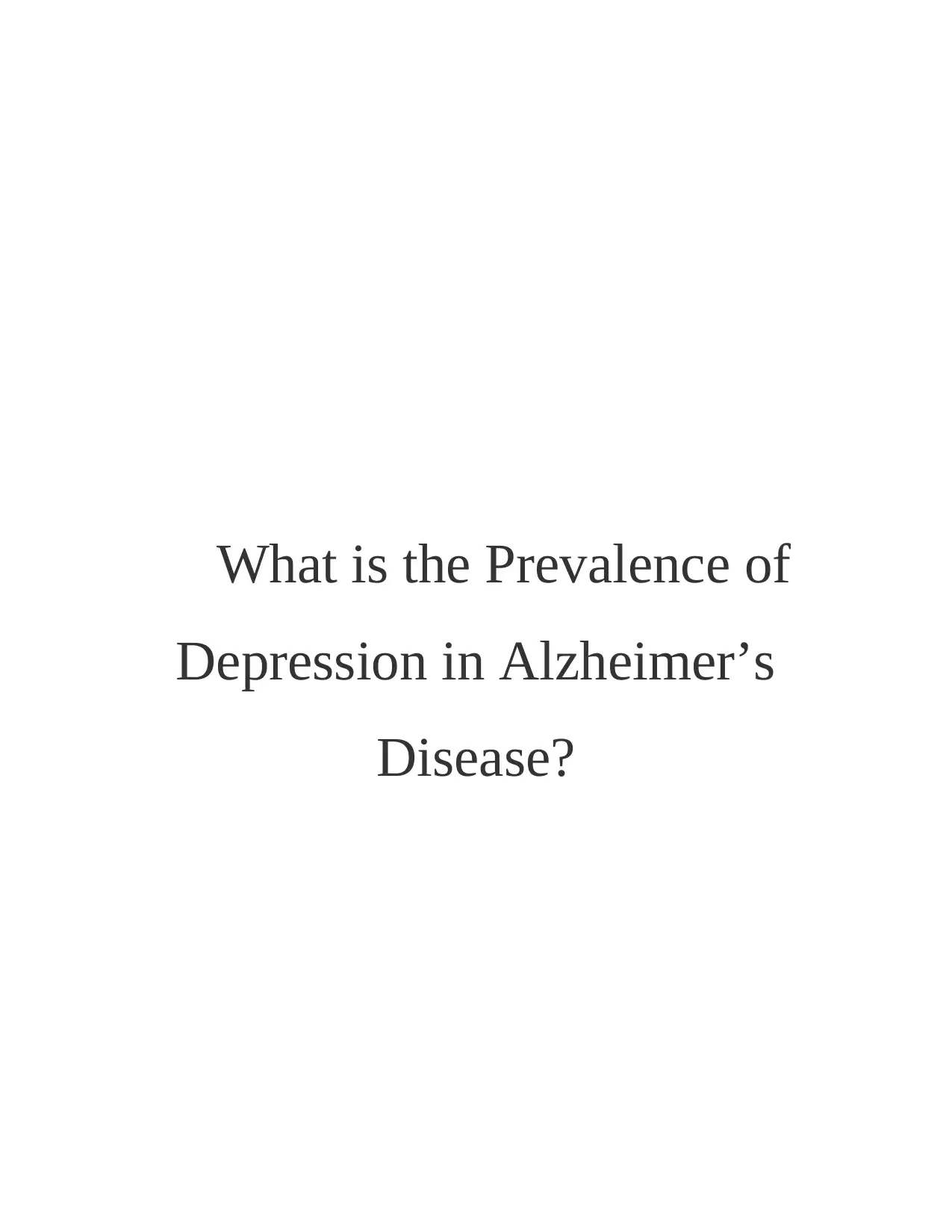
What is the Prevalence of
Depression in Alzheimer’s
Disease?
Depression in Alzheimer’s
Disease?
Paraphrase This Document
Need a fresh take? Get an instant paraphrase of this document with our AI Paraphraser
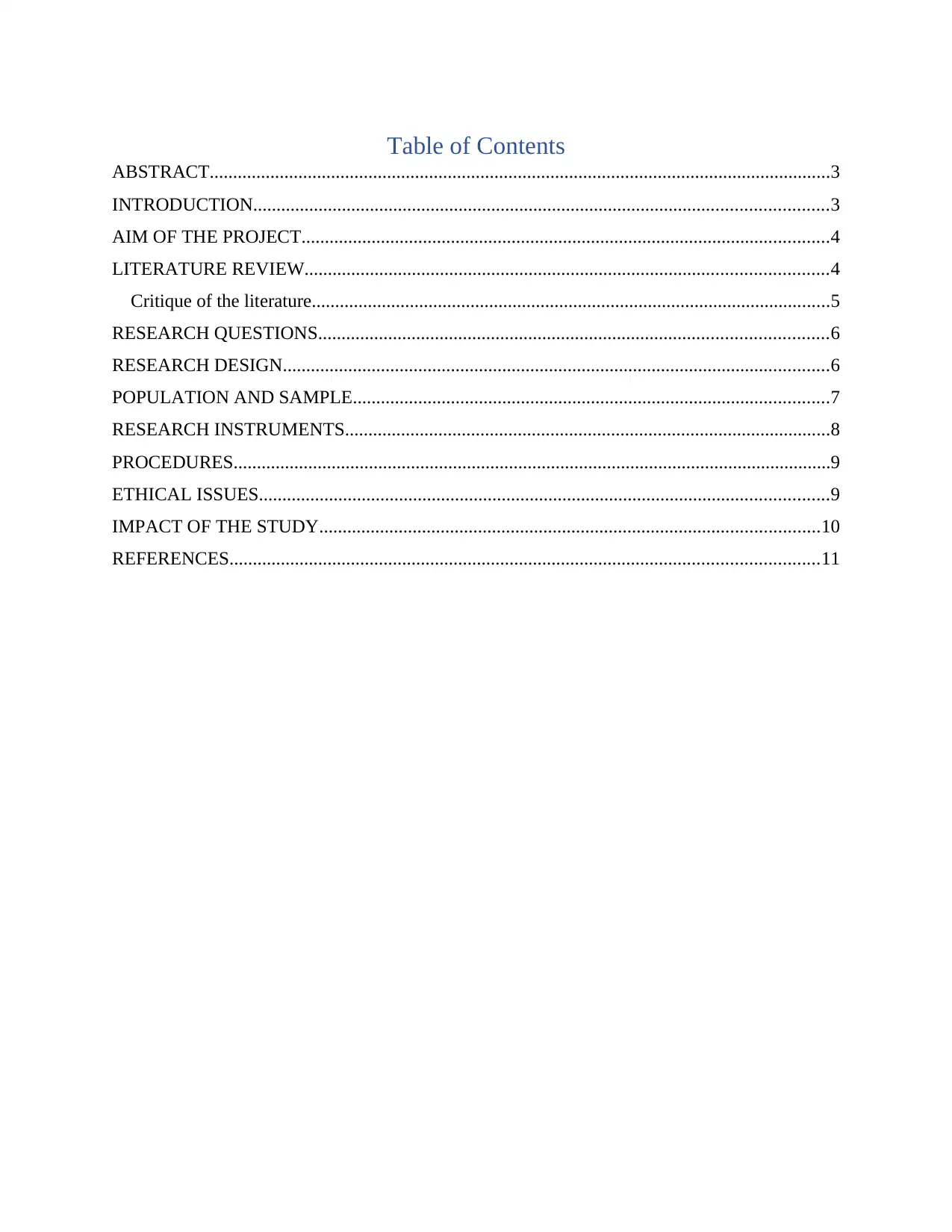
Table of Contents
ABSTRACT.....................................................................................................................................3
INTRODUCTION...........................................................................................................................3
AIM OF THE PROJECT.................................................................................................................4
LITERATURE REVIEW................................................................................................................4
Critique of the literature...............................................................................................................5
RESEARCH QUESTIONS.............................................................................................................6
RESEARCH DESIGN.....................................................................................................................6
POPULATION AND SAMPLE......................................................................................................7
RESEARCH INSTRUMENTS........................................................................................................8
PROCEDURES................................................................................................................................9
ETHICAL ISSUES..........................................................................................................................9
IMPACT OF THE STUDY...........................................................................................................10
REFERENCES..............................................................................................................................11
ABSTRACT.....................................................................................................................................3
INTRODUCTION...........................................................................................................................3
AIM OF THE PROJECT.................................................................................................................4
LITERATURE REVIEW................................................................................................................4
Critique of the literature...............................................................................................................5
RESEARCH QUESTIONS.............................................................................................................6
RESEARCH DESIGN.....................................................................................................................6
POPULATION AND SAMPLE......................................................................................................7
RESEARCH INSTRUMENTS........................................................................................................8
PROCEDURES................................................................................................................................9
ETHICAL ISSUES..........................................................................................................................9
IMPACT OF THE STUDY...........................................................................................................10
REFERENCES..............................................................................................................................11
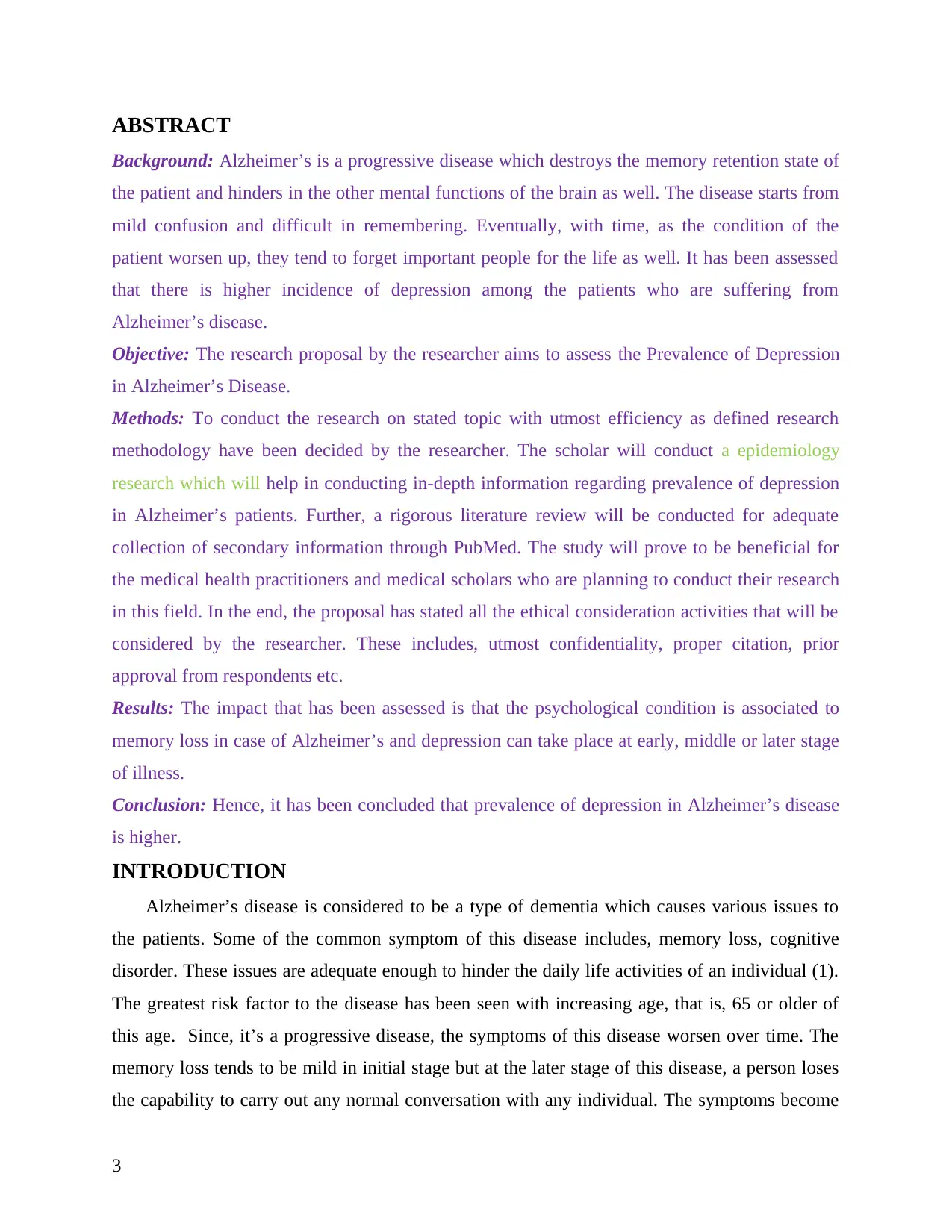
ABSTRACT
Background: Alzheimer’s is a progressive disease which destroys the memory retention state of
the patient and hinders in the other mental functions of the brain as well. The disease starts from
mild confusion and difficult in remembering. Eventually, with time, as the condition of the
patient worsen up, they tend to forget important people for the life as well. It has been assessed
that there is higher incidence of depression among the patients who are suffering from
Alzheimer’s disease.
Objective: The research proposal by the researcher aims to assess the Prevalence of Depression
in Alzheimer’s Disease.
Methods: To conduct the research on stated topic with utmost efficiency as defined research
methodology have been decided by the researcher. The scholar will conduct a epidemiology
research which will help in conducting in-depth information regarding prevalence of depression
in Alzheimer’s patients. Further, a rigorous literature review will be conducted for adequate
collection of secondary information through PubMed. The study will prove to be beneficial for
the medical health practitioners and medical scholars who are planning to conduct their research
in this field. In the end, the proposal has stated all the ethical consideration activities that will be
considered by the researcher. These includes, utmost confidentiality, proper citation, prior
approval from respondents etc.
Results: The impact that has been assessed is that the psychological condition is associated to
memory loss in case of Alzheimer’s and depression can take place at early, middle or later stage
of illness.
Conclusion: Hence, it has been concluded that prevalence of depression in Alzheimer’s disease
is higher.
INTRODUCTION
Alzheimer’s disease is considered to be a type of dementia which causes various issues to
the patients. Some of the common symptom of this disease includes, memory loss, cognitive
disorder. These issues are adequate enough to hinder the daily life activities of an individual (1).
The greatest risk factor to the disease has been seen with increasing age, that is, 65 or older of
this age. Since, it’s a progressive disease, the symptoms of this disease worsen over time. The
memory loss tends to be mild in initial stage but at the later stage of this disease, a person loses
the capability to carry out any normal conversation with any individual. The symptoms become
3
Background: Alzheimer’s is a progressive disease which destroys the memory retention state of
the patient and hinders in the other mental functions of the brain as well. The disease starts from
mild confusion and difficult in remembering. Eventually, with time, as the condition of the
patient worsen up, they tend to forget important people for the life as well. It has been assessed
that there is higher incidence of depression among the patients who are suffering from
Alzheimer’s disease.
Objective: The research proposal by the researcher aims to assess the Prevalence of Depression
in Alzheimer’s Disease.
Methods: To conduct the research on stated topic with utmost efficiency as defined research
methodology have been decided by the researcher. The scholar will conduct a epidemiology
research which will help in conducting in-depth information regarding prevalence of depression
in Alzheimer’s patients. Further, a rigorous literature review will be conducted for adequate
collection of secondary information through PubMed. The study will prove to be beneficial for
the medical health practitioners and medical scholars who are planning to conduct their research
in this field. In the end, the proposal has stated all the ethical consideration activities that will be
considered by the researcher. These includes, utmost confidentiality, proper citation, prior
approval from respondents etc.
Results: The impact that has been assessed is that the psychological condition is associated to
memory loss in case of Alzheimer’s and depression can take place at early, middle or later stage
of illness.
Conclusion: Hence, it has been concluded that prevalence of depression in Alzheimer’s disease
is higher.
INTRODUCTION
Alzheimer’s disease is considered to be a type of dementia which causes various issues to
the patients. Some of the common symptom of this disease includes, memory loss, cognitive
disorder. These issues are adequate enough to hinder the daily life activities of an individual (1).
The greatest risk factor to the disease has been seen with increasing age, that is, 65 or older of
this age. Since, it’s a progressive disease, the symptoms of this disease worsen over time. The
memory loss tends to be mild in initial stage but at the later stage of this disease, a person loses
the capability to carry out any normal conversation with any individual. The symptoms become
3
⊘ This is a preview!⊘
Do you want full access?
Subscribe today to unlock all pages.

Trusted by 1+ million students worldwide
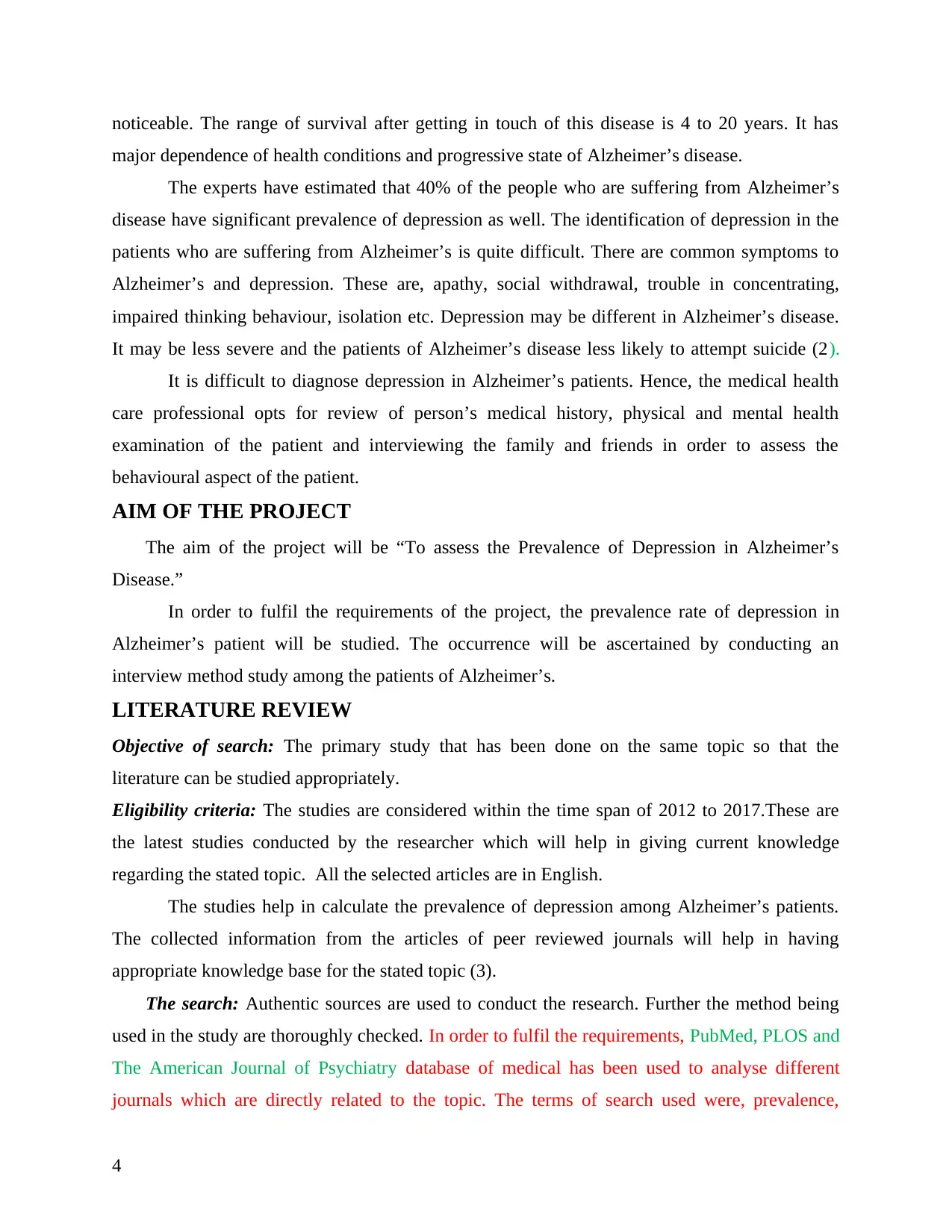
noticeable. The range of survival after getting in touch of this disease is 4 to 20 years. It has
major dependence of health conditions and progressive state of Alzheimer’s disease.
The experts have estimated that 40% of the people who are suffering from Alzheimer’s
disease have significant prevalence of depression as well. The identification of depression in the
patients who are suffering from Alzheimer’s is quite difficult. There are common symptoms to
Alzheimer’s and depression. These are, apathy, social withdrawal, trouble in concentrating,
impaired thinking behaviour, isolation etc. Depression may be different in Alzheimer’s disease.
It may be less severe and the patients of Alzheimer’s disease less likely to attempt suicide (2).
It is difficult to diagnose depression in Alzheimer’s patients. Hence, the medical health
care professional opts for review of person’s medical history, physical and mental health
examination of the patient and interviewing the family and friends in order to assess the
behavioural aspect of the patient.
AIM OF THE PROJECT
The aim of the project will be “To assess the Prevalence of Depression in Alzheimer’s
Disease.”
In order to fulfil the requirements of the project, the prevalence rate of depression in
Alzheimer’s patient will be studied. The occurrence will be ascertained by conducting an
interview method study among the patients of Alzheimer’s.
LITERATURE REVIEW
Objective of search: The primary study that has been done on the same topic so that the
literature can be studied appropriately.
Eligibility criteria: The studies are considered within the time span of 2012 to 2017.These are
the latest studies conducted by the researcher which will help in giving current knowledge
regarding the stated topic. All the selected articles are in English.
The studies help in calculate the prevalence of depression among Alzheimer’s patients.
The collected information from the articles of peer reviewed journals will help in having
appropriate knowledge base for the stated topic (3).
The search: Authentic sources are used to conduct the research. Further the method being
used in the study are thoroughly checked. In order to fulfil the requirements, PubMed, PLOS and
The American Journal of Psychiatry database of medical has been used to analyse different
journals which are directly related to the topic. The terms of search used were, prevalence,
4
major dependence of health conditions and progressive state of Alzheimer’s disease.
The experts have estimated that 40% of the people who are suffering from Alzheimer’s
disease have significant prevalence of depression as well. The identification of depression in the
patients who are suffering from Alzheimer’s is quite difficult. There are common symptoms to
Alzheimer’s and depression. These are, apathy, social withdrawal, trouble in concentrating,
impaired thinking behaviour, isolation etc. Depression may be different in Alzheimer’s disease.
It may be less severe and the patients of Alzheimer’s disease less likely to attempt suicide (2).
It is difficult to diagnose depression in Alzheimer’s patients. Hence, the medical health
care professional opts for review of person’s medical history, physical and mental health
examination of the patient and interviewing the family and friends in order to assess the
behavioural aspect of the patient.
AIM OF THE PROJECT
The aim of the project will be “To assess the Prevalence of Depression in Alzheimer’s
Disease.”
In order to fulfil the requirements of the project, the prevalence rate of depression in
Alzheimer’s patient will be studied. The occurrence will be ascertained by conducting an
interview method study among the patients of Alzheimer’s.
LITERATURE REVIEW
Objective of search: The primary study that has been done on the same topic so that the
literature can be studied appropriately.
Eligibility criteria: The studies are considered within the time span of 2012 to 2017.These are
the latest studies conducted by the researcher which will help in giving current knowledge
regarding the stated topic. All the selected articles are in English.
The studies help in calculate the prevalence of depression among Alzheimer’s patients.
The collected information from the articles of peer reviewed journals will help in having
appropriate knowledge base for the stated topic (3).
The search: Authentic sources are used to conduct the research. Further the method being
used in the study are thoroughly checked. In order to fulfil the requirements, PubMed, PLOS and
The American Journal of Psychiatry database of medical has been used to analyse different
journals which are directly related to the topic. The terms of search used were, prevalence,
4
Paraphrase This Document
Need a fresh take? Get an instant paraphrase of this document with our AI Paraphraser
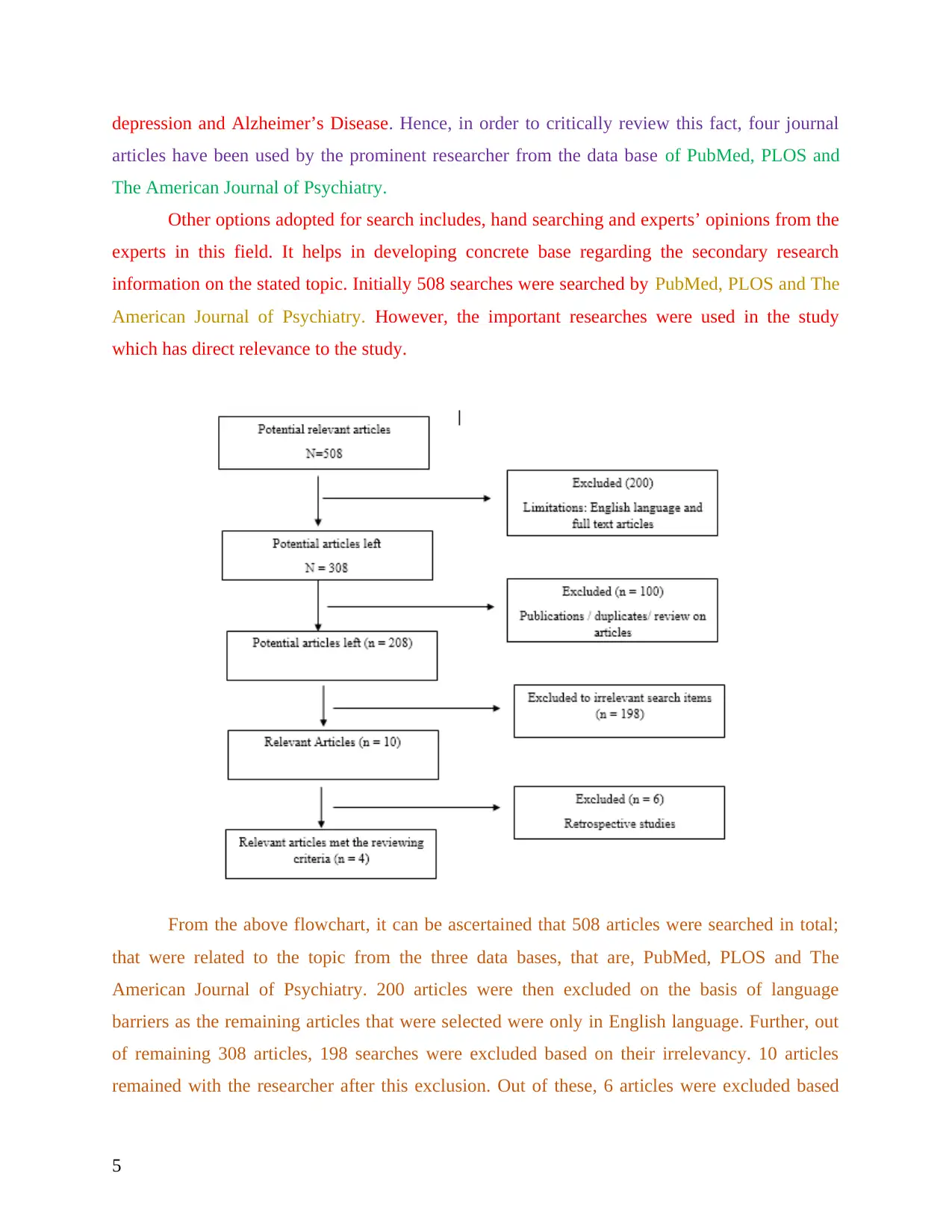
depression and Alzheimer’s Disease. Hence, in order to critically review this fact, four journal
articles have been used by the prominent researcher from the data base of PubMed, PLOS and
The American Journal of Psychiatry.
Other options adopted for search includes, hand searching and experts’ opinions from the
experts in this field. It helps in developing concrete base regarding the secondary research
information on the stated topic. Initially 508 searches were searched by PubMed, PLOS and The
American Journal of Psychiatry. However, the important researches were used in the study
which has direct relevance to the study.
From the above flowchart, it can be ascertained that 508 articles were searched in total;
that were related to the topic from the three data bases, that are, PubMed, PLOS and The
American Journal of Psychiatry. 200 articles were then excluded on the basis of language
barriers as the remaining articles that were selected were only in English language. Further, out
of remaining 308 articles, 198 searches were excluded based on their irrelevancy. 10 articles
remained with the researcher after this exclusion. Out of these, 6 articles were excluded based
5
articles have been used by the prominent researcher from the data base of PubMed, PLOS and
The American Journal of Psychiatry.
Other options adopted for search includes, hand searching and experts’ opinions from the
experts in this field. It helps in developing concrete base regarding the secondary research
information on the stated topic. Initially 508 searches were searched by PubMed, PLOS and The
American Journal of Psychiatry. However, the important researches were used in the study
which has direct relevance to the study.
From the above flowchart, it can be ascertained that 508 articles were searched in total;
that were related to the topic from the three data bases, that are, PubMed, PLOS and The
American Journal of Psychiatry. 200 articles were then excluded on the basis of language
barriers as the remaining articles that were selected were only in English language. Further, out
of remaining 308 articles, 198 searches were excluded based on their irrelevancy. 10 articles
remained with the researcher after this exclusion. Out of these, 6 articles were excluded based
5
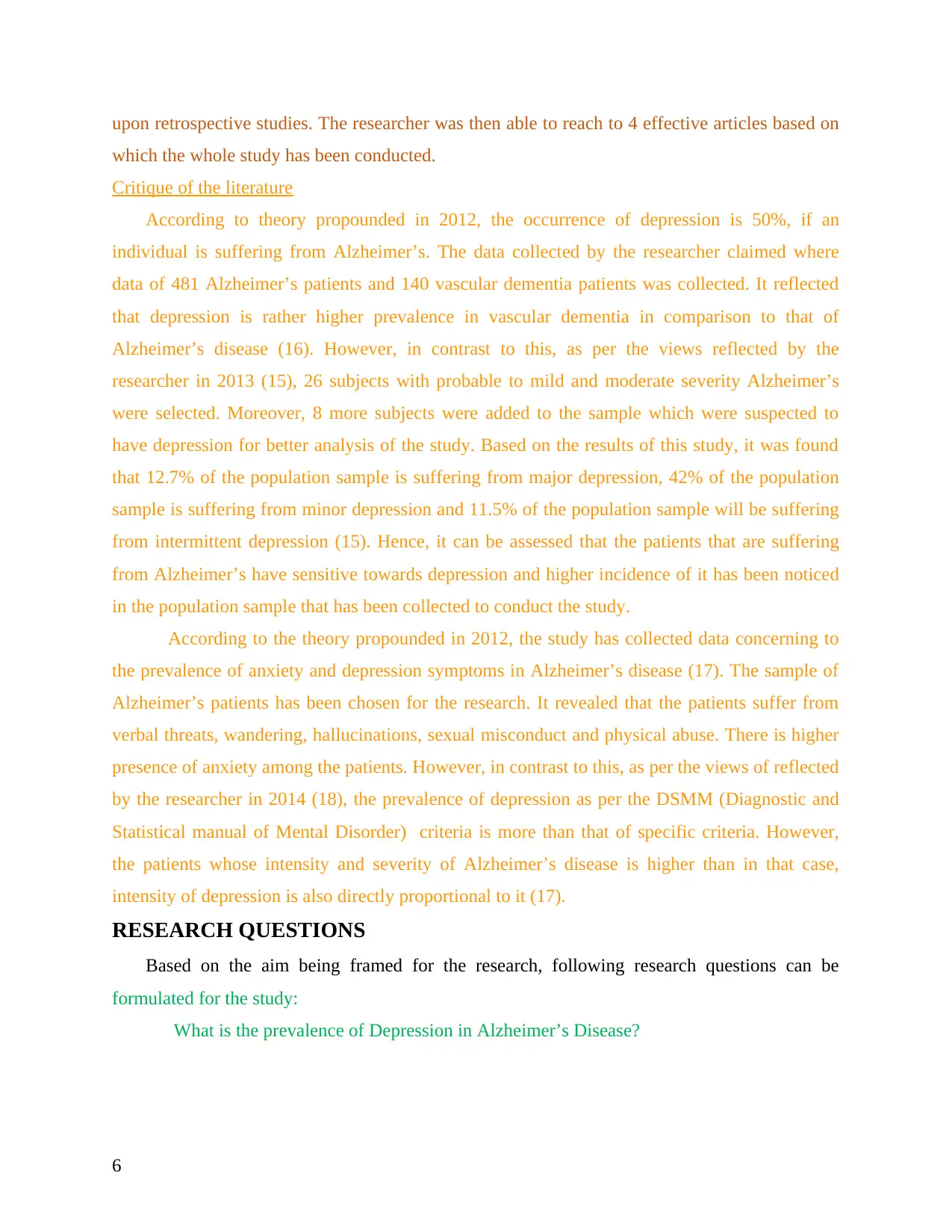
upon retrospective studies. The researcher was then able to reach to 4 effective articles based on
which the whole study has been conducted.
Critique of the literature
According to theory propounded in 2012, the occurrence of depression is 50%, if an
individual is suffering from Alzheimer’s. The data collected by the researcher claimed where
data of 481 Alzheimer’s patients and 140 vascular dementia patients was collected. It reflected
that depression is rather higher prevalence in vascular dementia in comparison to that of
Alzheimer’s disease (16). However, in contrast to this, as per the views reflected by the
researcher in 2013 (15), 26 subjects with probable to mild and moderate severity Alzheimer’s
were selected. Moreover, 8 more subjects were added to the sample which were suspected to
have depression for better analysis of the study. Based on the results of this study, it was found
that 12.7% of the population sample is suffering from major depression, 42% of the population
sample is suffering from minor depression and 11.5% of the population sample will be suffering
from intermittent depression (15). Hence, it can be assessed that the patients that are suffering
from Alzheimer’s have sensitive towards depression and higher incidence of it has been noticed
in the population sample that has been collected to conduct the study.
According to the theory propounded in 2012, the study has collected data concerning to
the prevalence of anxiety and depression symptoms in Alzheimer’s disease (17). The sample of
Alzheimer’s patients has been chosen for the research. It revealed that the patients suffer from
verbal threats, wandering, hallucinations, sexual misconduct and physical abuse. There is higher
presence of anxiety among the patients. However, in contrast to this, as per the views of reflected
by the researcher in 2014 (18), the prevalence of depression as per the DSMM (Diagnostic and
Statistical manual of Mental Disorder) criteria is more than that of specific criteria. However,
the patients whose intensity and severity of Alzheimer’s disease is higher than in that case,
intensity of depression is also directly proportional to it (17).
RESEARCH QUESTIONS
Based on the aim being framed for the research, following research questions can be
formulated for the study:
What is the prevalence of Depression in Alzheimer’s Disease?
6
which the whole study has been conducted.
Critique of the literature
According to theory propounded in 2012, the occurrence of depression is 50%, if an
individual is suffering from Alzheimer’s. The data collected by the researcher claimed where
data of 481 Alzheimer’s patients and 140 vascular dementia patients was collected. It reflected
that depression is rather higher prevalence in vascular dementia in comparison to that of
Alzheimer’s disease (16). However, in contrast to this, as per the views reflected by the
researcher in 2013 (15), 26 subjects with probable to mild and moderate severity Alzheimer’s
were selected. Moreover, 8 more subjects were added to the sample which were suspected to
have depression for better analysis of the study. Based on the results of this study, it was found
that 12.7% of the population sample is suffering from major depression, 42% of the population
sample is suffering from minor depression and 11.5% of the population sample will be suffering
from intermittent depression (15). Hence, it can be assessed that the patients that are suffering
from Alzheimer’s have sensitive towards depression and higher incidence of it has been noticed
in the population sample that has been collected to conduct the study.
According to the theory propounded in 2012, the study has collected data concerning to
the prevalence of anxiety and depression symptoms in Alzheimer’s disease (17). The sample of
Alzheimer’s patients has been chosen for the research. It revealed that the patients suffer from
verbal threats, wandering, hallucinations, sexual misconduct and physical abuse. There is higher
presence of anxiety among the patients. However, in contrast to this, as per the views of reflected
by the researcher in 2014 (18), the prevalence of depression as per the DSMM (Diagnostic and
Statistical manual of Mental Disorder) criteria is more than that of specific criteria. However,
the patients whose intensity and severity of Alzheimer’s disease is higher than in that case,
intensity of depression is also directly proportional to it (17).
RESEARCH QUESTIONS
Based on the aim being framed for the research, following research questions can be
formulated for the study:
What is the prevalence of Depression in Alzheimer’s Disease?
6
⊘ This is a preview!⊘
Do you want full access?
Subscribe today to unlock all pages.

Trusted by 1+ million students worldwide
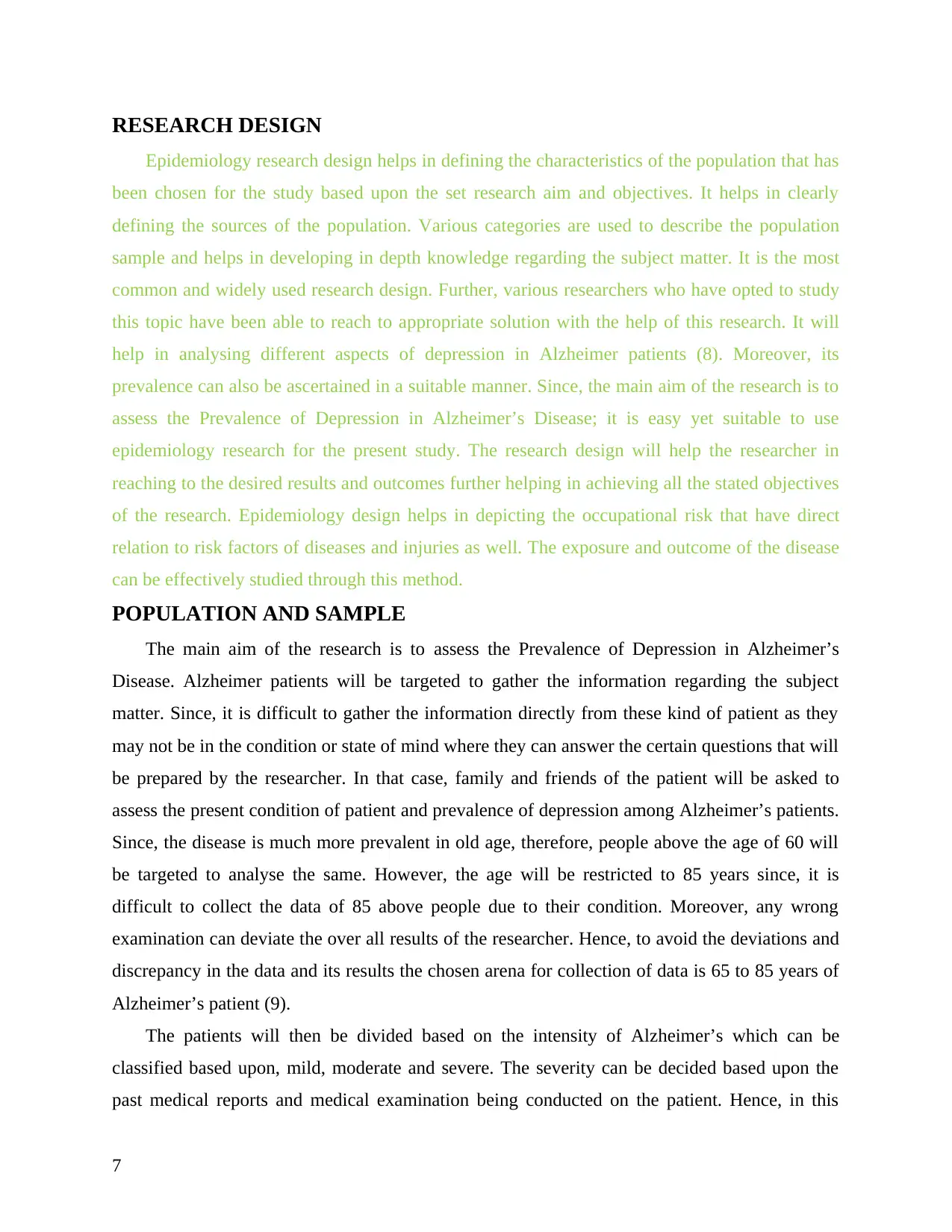
RESEARCH DESIGN
Epidemiology research design helps in defining the characteristics of the population that has
been chosen for the study based upon the set research aim and objectives. It helps in clearly
defining the sources of the population. Various categories are used to describe the population
sample and helps in developing in depth knowledge regarding the subject matter. It is the most
common and widely used research design. Further, various researchers who have opted to study
this topic have been able to reach to appropriate solution with the help of this research. It will
help in analysing different aspects of depression in Alzheimer patients (8). Moreover, its
prevalence can also be ascertained in a suitable manner. Since, the main aim of the research is to
assess the Prevalence of Depression in Alzheimer’s Disease; it is easy yet suitable to use
epidemiology research for the present study. The research design will help the researcher in
reaching to the desired results and outcomes further helping in achieving all the stated objectives
of the research. Epidemiology design helps in depicting the occupational risk that have direct
relation to risk factors of diseases and injuries as well. The exposure and outcome of the disease
can be effectively studied through this method.
POPULATION AND SAMPLE
The main aim of the research is to assess the Prevalence of Depression in Alzheimer’s
Disease. Alzheimer patients will be targeted to gather the information regarding the subject
matter. Since, it is difficult to gather the information directly from these kind of patient as they
may not be in the condition or state of mind where they can answer the certain questions that will
be prepared by the researcher. In that case, family and friends of the patient will be asked to
assess the present condition of patient and prevalence of depression among Alzheimer’s patients.
Since, the disease is much more prevalent in old age, therefore, people above the age of 60 will
be targeted to analyse the same. However, the age will be restricted to 85 years since, it is
difficult to collect the data of 85 above people due to their condition. Moreover, any wrong
examination can deviate the over all results of the researcher. Hence, to avoid the deviations and
discrepancy in the data and its results the chosen arena for collection of data is 65 to 85 years of
Alzheimer’s patient (9).
The patients will then be divided based on the intensity of Alzheimer’s which can be
classified based upon, mild, moderate and severe. The severity can be decided based upon the
past medical reports and medical examination being conducted on the patient. Hence, in this
7
Epidemiology research design helps in defining the characteristics of the population that has
been chosen for the study based upon the set research aim and objectives. It helps in clearly
defining the sources of the population. Various categories are used to describe the population
sample and helps in developing in depth knowledge regarding the subject matter. It is the most
common and widely used research design. Further, various researchers who have opted to study
this topic have been able to reach to appropriate solution with the help of this research. It will
help in analysing different aspects of depression in Alzheimer patients (8). Moreover, its
prevalence can also be ascertained in a suitable manner. Since, the main aim of the research is to
assess the Prevalence of Depression in Alzheimer’s Disease; it is easy yet suitable to use
epidemiology research for the present study. The research design will help the researcher in
reaching to the desired results and outcomes further helping in achieving all the stated objectives
of the research. Epidemiology design helps in depicting the occupational risk that have direct
relation to risk factors of diseases and injuries as well. The exposure and outcome of the disease
can be effectively studied through this method.
POPULATION AND SAMPLE
The main aim of the research is to assess the Prevalence of Depression in Alzheimer’s
Disease. Alzheimer patients will be targeted to gather the information regarding the subject
matter. Since, it is difficult to gather the information directly from these kind of patient as they
may not be in the condition or state of mind where they can answer the certain questions that will
be prepared by the researcher. In that case, family and friends of the patient will be asked to
assess the present condition of patient and prevalence of depression among Alzheimer’s patients.
Since, the disease is much more prevalent in old age, therefore, people above the age of 60 will
be targeted to analyse the same. However, the age will be restricted to 85 years since, it is
difficult to collect the data of 85 above people due to their condition. Moreover, any wrong
examination can deviate the over all results of the researcher. Hence, to avoid the deviations and
discrepancy in the data and its results the chosen arena for collection of data is 65 to 85 years of
Alzheimer’s patient (9).
The patients will then be divided based on the intensity of Alzheimer’s which can be
classified based upon, mild, moderate and severe. The severity can be decided based upon the
past medical reports and medical examination being conducted on the patient. Hence, in this
7
Paraphrase This Document
Need a fresh take? Get an instant paraphrase of this document with our AI Paraphraser
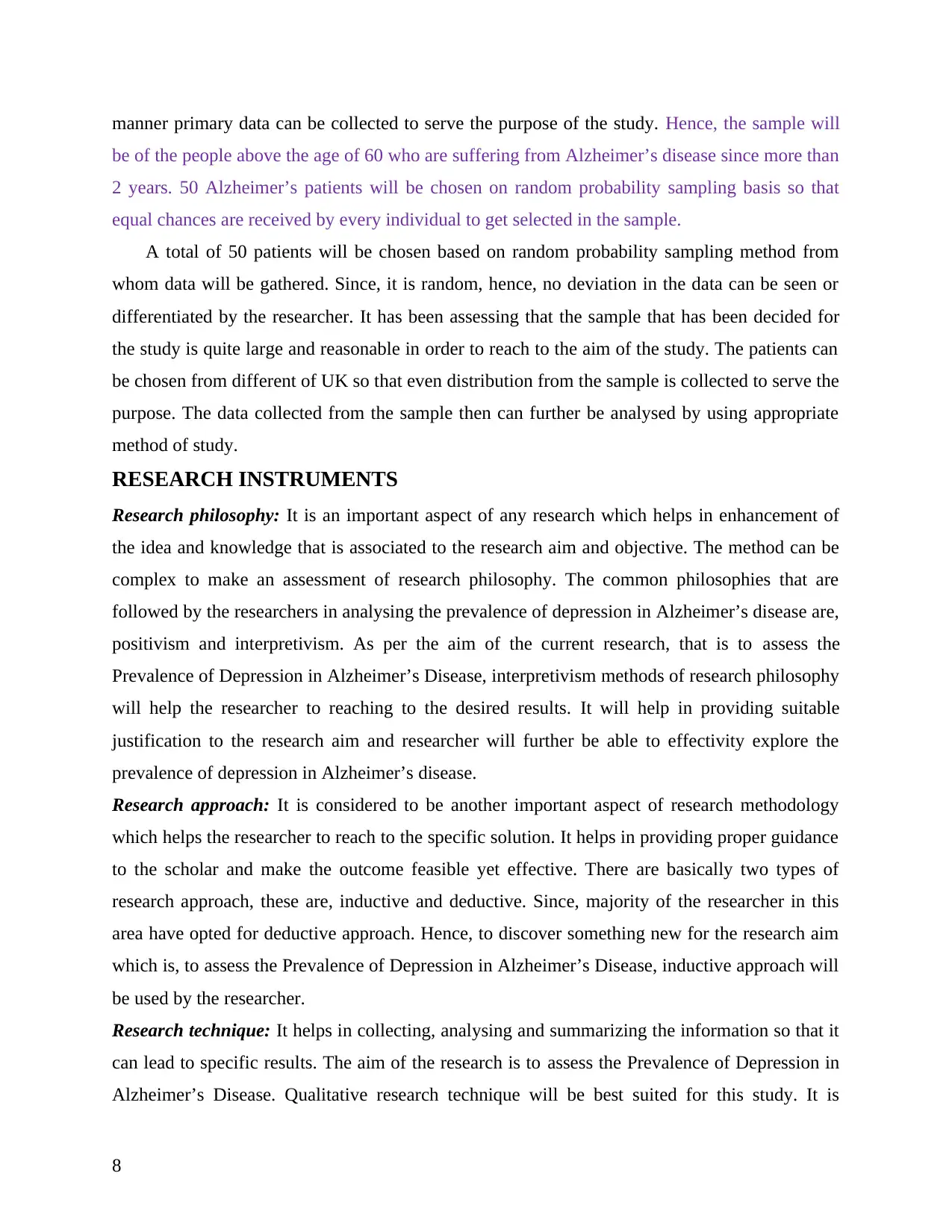
manner primary data can be collected to serve the purpose of the study. Hence, the sample will
be of the people above the age of 60 who are suffering from Alzheimer’s disease since more than
2 years. 50 Alzheimer’s patients will be chosen on random probability sampling basis so that
equal chances are received by every individual to get selected in the sample.
A total of 50 patients will be chosen based on random probability sampling method from
whom data will be gathered. Since, it is random, hence, no deviation in the data can be seen or
differentiated by the researcher. It has been assessing that the sample that has been decided for
the study is quite large and reasonable in order to reach to the aim of the study. The patients can
be chosen from different of UK so that even distribution from the sample is collected to serve the
purpose. The data collected from the sample then can further be analysed by using appropriate
method of study.
RESEARCH INSTRUMENTS
Research philosophy: It is an important aspect of any research which helps in enhancement of
the idea and knowledge that is associated to the research aim and objective. The method can be
complex to make an assessment of research philosophy. The common philosophies that are
followed by the researchers in analysing the prevalence of depression in Alzheimer’s disease are,
positivism and interpretivism. As per the aim of the current research, that is to assess the
Prevalence of Depression in Alzheimer’s Disease, interpretivism methods of research philosophy
will help the researcher to reaching to the desired results. It will help in providing suitable
justification to the research aim and researcher will further be able to effectivity explore the
prevalence of depression in Alzheimer’s disease.
Research approach: It is considered to be another important aspect of research methodology
which helps the researcher to reach to the specific solution. It helps in providing proper guidance
to the scholar and make the outcome feasible yet effective. There are basically two types of
research approach, these are, inductive and deductive. Since, majority of the researcher in this
area have opted for deductive approach. Hence, to discover something new for the research aim
which is, to assess the Prevalence of Depression in Alzheimer’s Disease, inductive approach will
be used by the researcher.
Research technique: It helps in collecting, analysing and summarizing the information so that it
can lead to specific results. The aim of the research is to assess the Prevalence of Depression in
Alzheimer’s Disease. Qualitative research technique will be best suited for this study. It is
8
be of the people above the age of 60 who are suffering from Alzheimer’s disease since more than
2 years. 50 Alzheimer’s patients will be chosen on random probability sampling basis so that
equal chances are received by every individual to get selected in the sample.
A total of 50 patients will be chosen based on random probability sampling method from
whom data will be gathered. Since, it is random, hence, no deviation in the data can be seen or
differentiated by the researcher. It has been assessing that the sample that has been decided for
the study is quite large and reasonable in order to reach to the aim of the study. The patients can
be chosen from different of UK so that even distribution from the sample is collected to serve the
purpose. The data collected from the sample then can further be analysed by using appropriate
method of study.
RESEARCH INSTRUMENTS
Research philosophy: It is an important aspect of any research which helps in enhancement of
the idea and knowledge that is associated to the research aim and objective. The method can be
complex to make an assessment of research philosophy. The common philosophies that are
followed by the researchers in analysing the prevalence of depression in Alzheimer’s disease are,
positivism and interpretivism. As per the aim of the current research, that is to assess the
Prevalence of Depression in Alzheimer’s Disease, interpretivism methods of research philosophy
will help the researcher to reaching to the desired results. It will help in providing suitable
justification to the research aim and researcher will further be able to effectivity explore the
prevalence of depression in Alzheimer’s disease.
Research approach: It is considered to be another important aspect of research methodology
which helps the researcher to reach to the specific solution. It helps in providing proper guidance
to the scholar and make the outcome feasible yet effective. There are basically two types of
research approach, these are, inductive and deductive. Since, majority of the researcher in this
area have opted for deductive approach. Hence, to discover something new for the research aim
which is, to assess the Prevalence of Depression in Alzheimer’s Disease, inductive approach will
be used by the researcher.
Research technique: It helps in collecting, analysing and summarizing the information so that it
can lead to specific results. The aim of the research is to assess the Prevalence of Depression in
Alzheimer’s Disease. Qualitative research technique will be best suited for this study. It is
8
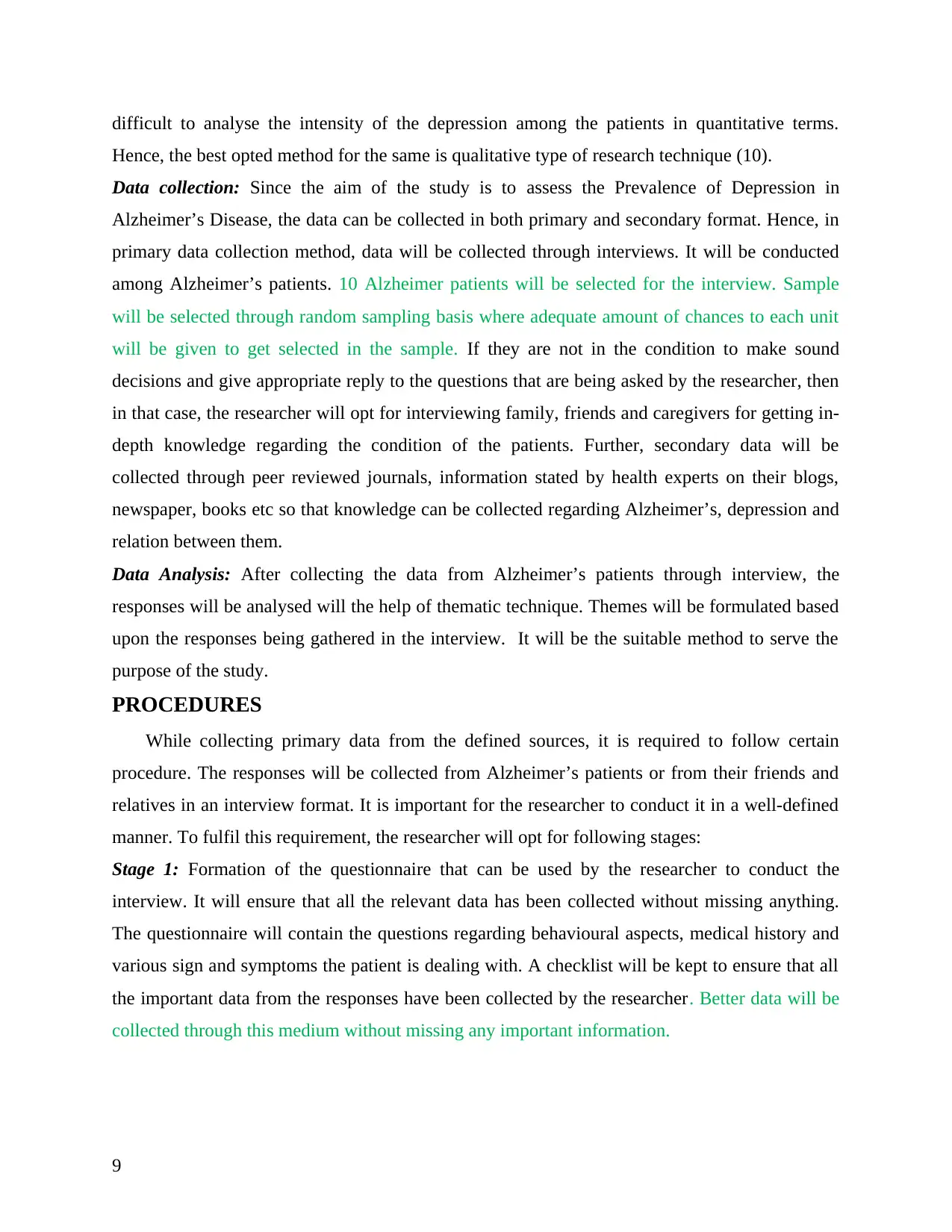
difficult to analyse the intensity of the depression among the patients in quantitative terms.
Hence, the best opted method for the same is qualitative type of research technique (10).
Data collection: Since the aim of the study is to assess the Prevalence of Depression in
Alzheimer’s Disease, the data can be collected in both primary and secondary format. Hence, in
primary data collection method, data will be collected through interviews. It will be conducted
among Alzheimer’s patients. 10 Alzheimer patients will be selected for the interview. Sample
will be selected through random sampling basis where adequate amount of chances to each unit
will be given to get selected in the sample. If they are not in the condition to make sound
decisions and give appropriate reply to the questions that are being asked by the researcher, then
in that case, the researcher will opt for interviewing family, friends and caregivers for getting in-
depth knowledge regarding the condition of the patients. Further, secondary data will be
collected through peer reviewed journals, information stated by health experts on their blogs,
newspaper, books etc so that knowledge can be collected regarding Alzheimer’s, depression and
relation between them.
Data Analysis: After collecting the data from Alzheimer’s patients through interview, the
responses will be analysed will the help of thematic technique. Themes will be formulated based
upon the responses being gathered in the interview. It will be the suitable method to serve the
purpose of the study.
PROCEDURES
While collecting primary data from the defined sources, it is required to follow certain
procedure. The responses will be collected from Alzheimer’s patients or from their friends and
relatives in an interview format. It is important for the researcher to conduct it in a well-defined
manner. To fulfil this requirement, the researcher will opt for following stages:
Stage 1: Formation of the questionnaire that can be used by the researcher to conduct the
interview. It will ensure that all the relevant data has been collected without missing anything.
The questionnaire will contain the questions regarding behavioural aspects, medical history and
various sign and symptoms the patient is dealing with. A checklist will be kept to ensure that all
the important data from the responses have been collected by the researcher. Better data will be
collected through this medium without missing any important information.
9
Hence, the best opted method for the same is qualitative type of research technique (10).
Data collection: Since the aim of the study is to assess the Prevalence of Depression in
Alzheimer’s Disease, the data can be collected in both primary and secondary format. Hence, in
primary data collection method, data will be collected through interviews. It will be conducted
among Alzheimer’s patients. 10 Alzheimer patients will be selected for the interview. Sample
will be selected through random sampling basis where adequate amount of chances to each unit
will be given to get selected in the sample. If they are not in the condition to make sound
decisions and give appropriate reply to the questions that are being asked by the researcher, then
in that case, the researcher will opt for interviewing family, friends and caregivers for getting in-
depth knowledge regarding the condition of the patients. Further, secondary data will be
collected through peer reviewed journals, information stated by health experts on their blogs,
newspaper, books etc so that knowledge can be collected regarding Alzheimer’s, depression and
relation between them.
Data Analysis: After collecting the data from Alzheimer’s patients through interview, the
responses will be analysed will the help of thematic technique. Themes will be formulated based
upon the responses being gathered in the interview. It will be the suitable method to serve the
purpose of the study.
PROCEDURES
While collecting primary data from the defined sources, it is required to follow certain
procedure. The responses will be collected from Alzheimer’s patients or from their friends and
relatives in an interview format. It is important for the researcher to conduct it in a well-defined
manner. To fulfil this requirement, the researcher will opt for following stages:
Stage 1: Formation of the questionnaire that can be used by the researcher to conduct the
interview. It will ensure that all the relevant data has been collected without missing anything.
The questionnaire will contain the questions regarding behavioural aspects, medical history and
various sign and symptoms the patient is dealing with. A checklist will be kept to ensure that all
the important data from the responses have been collected by the researcher. Better data will be
collected through this medium without missing any important information.
9
⊘ This is a preview!⊘
Do you want full access?
Subscribe today to unlock all pages.

Trusted by 1+ million students worldwide
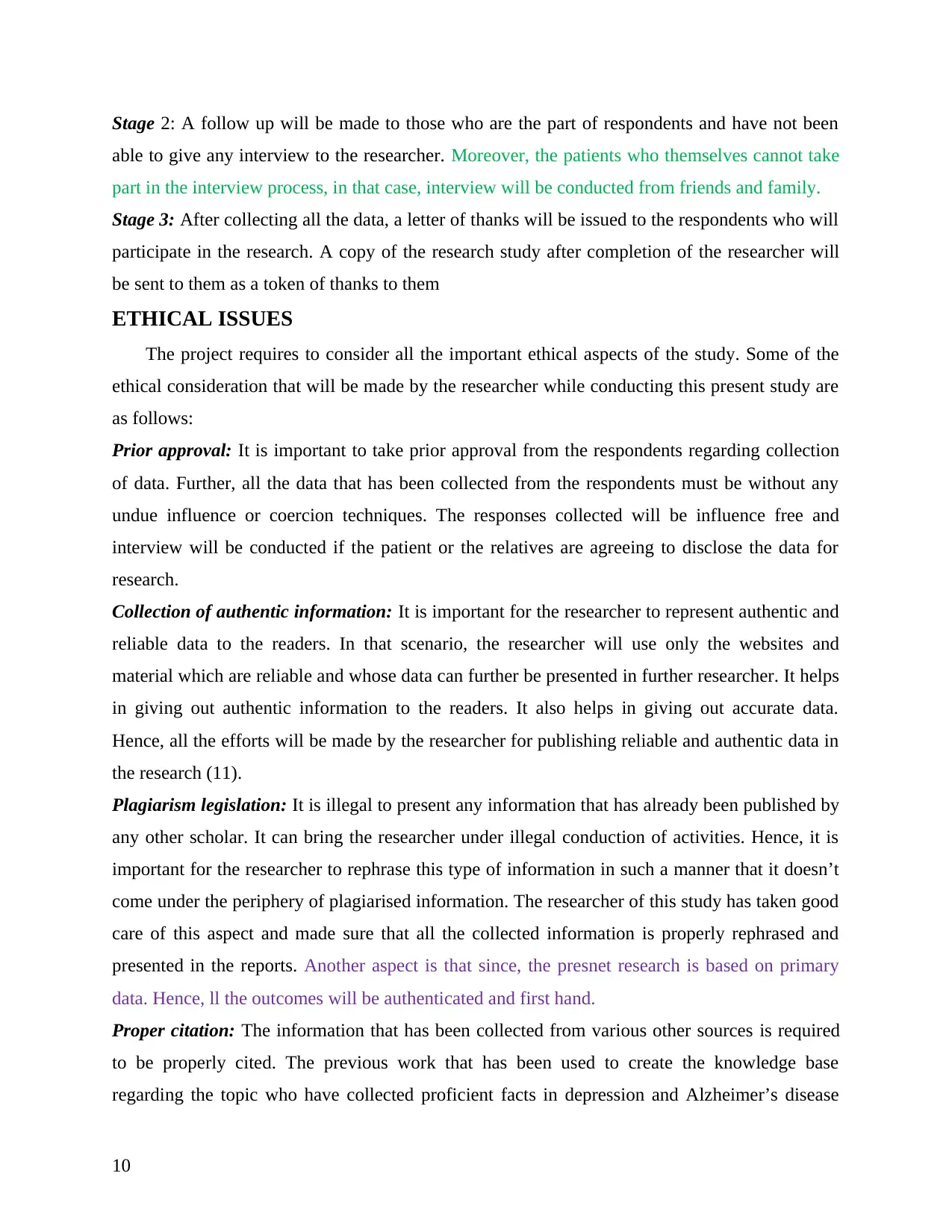
Stage 2: A follow up will be made to those who are the part of respondents and have not been
able to give any interview to the researcher. Moreover, the patients who themselves cannot take
part in the interview process, in that case, interview will be conducted from friends and family.
Stage 3: After collecting all the data, a letter of thanks will be issued to the respondents who will
participate in the research. A copy of the research study after completion of the researcher will
be sent to them as a token of thanks to them
ETHICAL ISSUES
The project requires to consider all the important ethical aspects of the study. Some of the
ethical consideration that will be made by the researcher while conducting this present study are
as follows:
Prior approval: It is important to take prior approval from the respondents regarding collection
of data. Further, all the data that has been collected from the respondents must be without any
undue influence or coercion techniques. The responses collected will be influence free and
interview will be conducted if the patient or the relatives are agreeing to disclose the data for
research.
Collection of authentic information: It is important for the researcher to represent authentic and
reliable data to the readers. In that scenario, the researcher will use only the websites and
material which are reliable and whose data can further be presented in further researcher. It helps
in giving out authentic information to the readers. It also helps in giving out accurate data.
Hence, all the efforts will be made by the researcher for publishing reliable and authentic data in
the research (11).
Plagiarism legislation: It is illegal to present any information that has already been published by
any other scholar. It can bring the researcher under illegal conduction of activities. Hence, it is
important for the researcher to rephrase this type of information in such a manner that it doesn’t
come under the periphery of plagiarised information. The researcher of this study has taken good
care of this aspect and made sure that all the collected information is properly rephrased and
presented in the reports. Another aspect is that since, the presnet research is based on primary
data. Hence, ll the outcomes will be authenticated and first hand.
Proper citation: The information that has been collected from various other sources is required
to be properly cited. The previous work that has been used to create the knowledge base
regarding the topic who have collected proficient facts in depression and Alzheimer’s disease
10
able to give any interview to the researcher. Moreover, the patients who themselves cannot take
part in the interview process, in that case, interview will be conducted from friends and family.
Stage 3: After collecting all the data, a letter of thanks will be issued to the respondents who will
participate in the research. A copy of the research study after completion of the researcher will
be sent to them as a token of thanks to them
ETHICAL ISSUES
The project requires to consider all the important ethical aspects of the study. Some of the
ethical consideration that will be made by the researcher while conducting this present study are
as follows:
Prior approval: It is important to take prior approval from the respondents regarding collection
of data. Further, all the data that has been collected from the respondents must be without any
undue influence or coercion techniques. The responses collected will be influence free and
interview will be conducted if the patient or the relatives are agreeing to disclose the data for
research.
Collection of authentic information: It is important for the researcher to represent authentic and
reliable data to the readers. In that scenario, the researcher will use only the websites and
material which are reliable and whose data can further be presented in further researcher. It helps
in giving out authentic information to the readers. It also helps in giving out accurate data.
Hence, all the efforts will be made by the researcher for publishing reliable and authentic data in
the research (11).
Plagiarism legislation: It is illegal to present any information that has already been published by
any other scholar. It can bring the researcher under illegal conduction of activities. Hence, it is
important for the researcher to rephrase this type of information in such a manner that it doesn’t
come under the periphery of plagiarised information. The researcher of this study has taken good
care of this aspect and made sure that all the collected information is properly rephrased and
presented in the reports. Another aspect is that since, the presnet research is based on primary
data. Hence, ll the outcomes will be authenticated and first hand.
Proper citation: The information that has been collected from various other sources is required
to be properly cited. The previous work that has been used to create the knowledge base
regarding the topic who have collected proficient facts in depression and Alzheimer’s disease
10
Paraphrase This Document
Need a fresh take? Get an instant paraphrase of this document with our AI Paraphraser
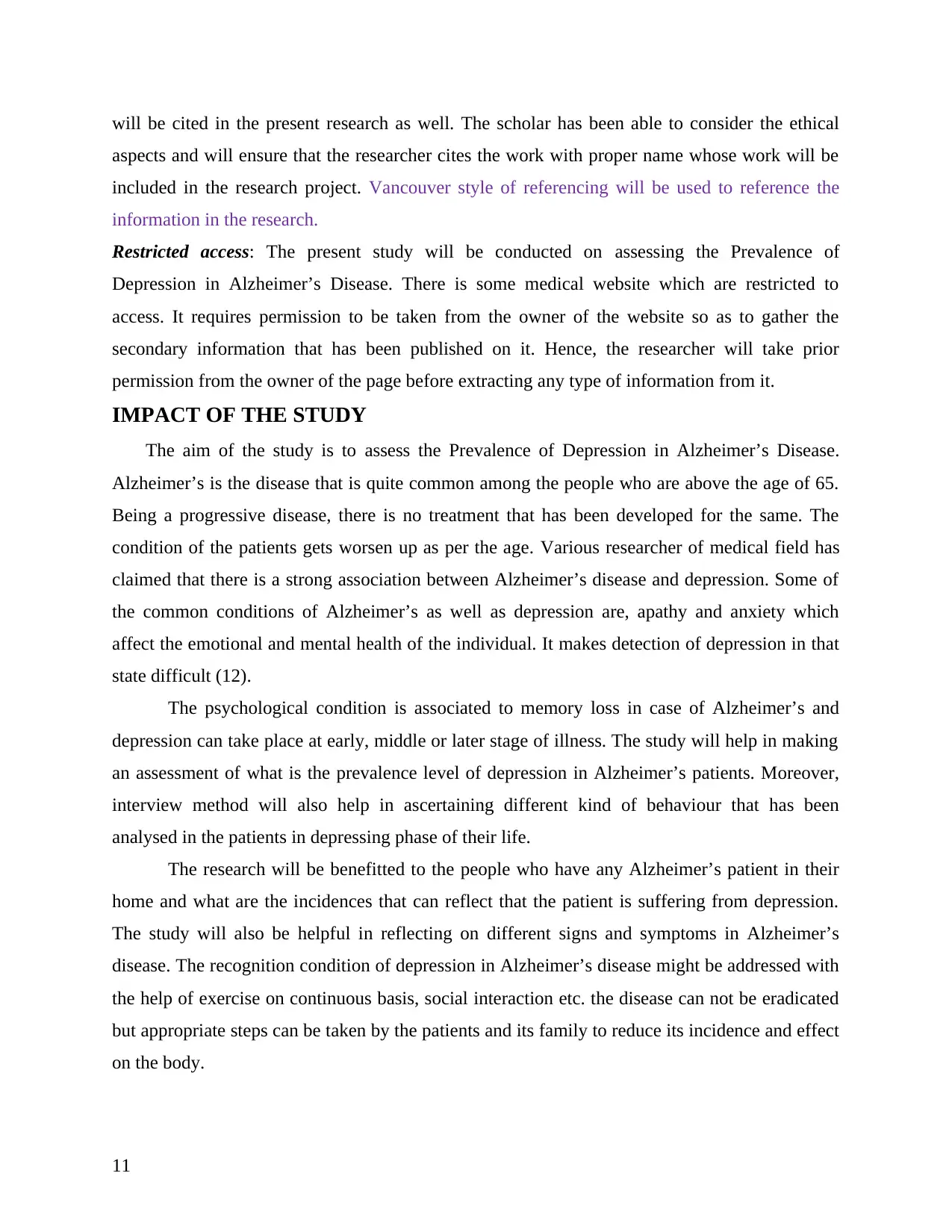
will be cited in the present research as well. The scholar has been able to consider the ethical
aspects and will ensure that the researcher cites the work with proper name whose work will be
included in the research project. Vancouver style of referencing will be used to reference the
information in the research.
Restricted access: The present study will be conducted on assessing the Prevalence of
Depression in Alzheimer’s Disease. There is some medical website which are restricted to
access. It requires permission to be taken from the owner of the website so as to gather the
secondary information that has been published on it. Hence, the researcher will take prior
permission from the owner of the page before extracting any type of information from it.
IMPACT OF THE STUDY
The aim of the study is to assess the Prevalence of Depression in Alzheimer’s Disease.
Alzheimer’s is the disease that is quite common among the people who are above the age of 65.
Being a progressive disease, there is no treatment that has been developed for the same. The
condition of the patients gets worsen up as per the age. Various researcher of medical field has
claimed that there is a strong association between Alzheimer’s disease and depression. Some of
the common conditions of Alzheimer’s as well as depression are, apathy and anxiety which
affect the emotional and mental health of the individual. It makes detection of depression in that
state difficult (12).
The psychological condition is associated to memory loss in case of Alzheimer’s and
depression can take place at early, middle or later stage of illness. The study will help in making
an assessment of what is the prevalence level of depression in Alzheimer’s patients. Moreover,
interview method will also help in ascertaining different kind of behaviour that has been
analysed in the patients in depressing phase of their life.
The research will be benefitted to the people who have any Alzheimer’s patient in their
home and what are the incidences that can reflect that the patient is suffering from depression.
The study will also be helpful in reflecting on different signs and symptoms in Alzheimer’s
disease. The recognition condition of depression in Alzheimer’s disease might be addressed with
the help of exercise on continuous basis, social interaction etc. the disease can not be eradicated
but appropriate steps can be taken by the patients and its family to reduce its incidence and effect
on the body.
11
aspects and will ensure that the researcher cites the work with proper name whose work will be
included in the research project. Vancouver style of referencing will be used to reference the
information in the research.
Restricted access: The present study will be conducted on assessing the Prevalence of
Depression in Alzheimer’s Disease. There is some medical website which are restricted to
access. It requires permission to be taken from the owner of the website so as to gather the
secondary information that has been published on it. Hence, the researcher will take prior
permission from the owner of the page before extracting any type of information from it.
IMPACT OF THE STUDY
The aim of the study is to assess the Prevalence of Depression in Alzheimer’s Disease.
Alzheimer’s is the disease that is quite common among the people who are above the age of 65.
Being a progressive disease, there is no treatment that has been developed for the same. The
condition of the patients gets worsen up as per the age. Various researcher of medical field has
claimed that there is a strong association between Alzheimer’s disease and depression. Some of
the common conditions of Alzheimer’s as well as depression are, apathy and anxiety which
affect the emotional and mental health of the individual. It makes detection of depression in that
state difficult (12).
The psychological condition is associated to memory loss in case of Alzheimer’s and
depression can take place at early, middle or later stage of illness. The study will help in making
an assessment of what is the prevalence level of depression in Alzheimer’s patients. Moreover,
interview method will also help in ascertaining different kind of behaviour that has been
analysed in the patients in depressing phase of their life.
The research will be benefitted to the people who have any Alzheimer’s patient in their
home and what are the incidences that can reflect that the patient is suffering from depression.
The study will also be helpful in reflecting on different signs and symptoms in Alzheimer’s
disease. The recognition condition of depression in Alzheimer’s disease might be addressed with
the help of exercise on continuous basis, social interaction etc. the disease can not be eradicated
but appropriate steps can be taken by the patients and its family to reduce its incidence and effect
on the body.
11
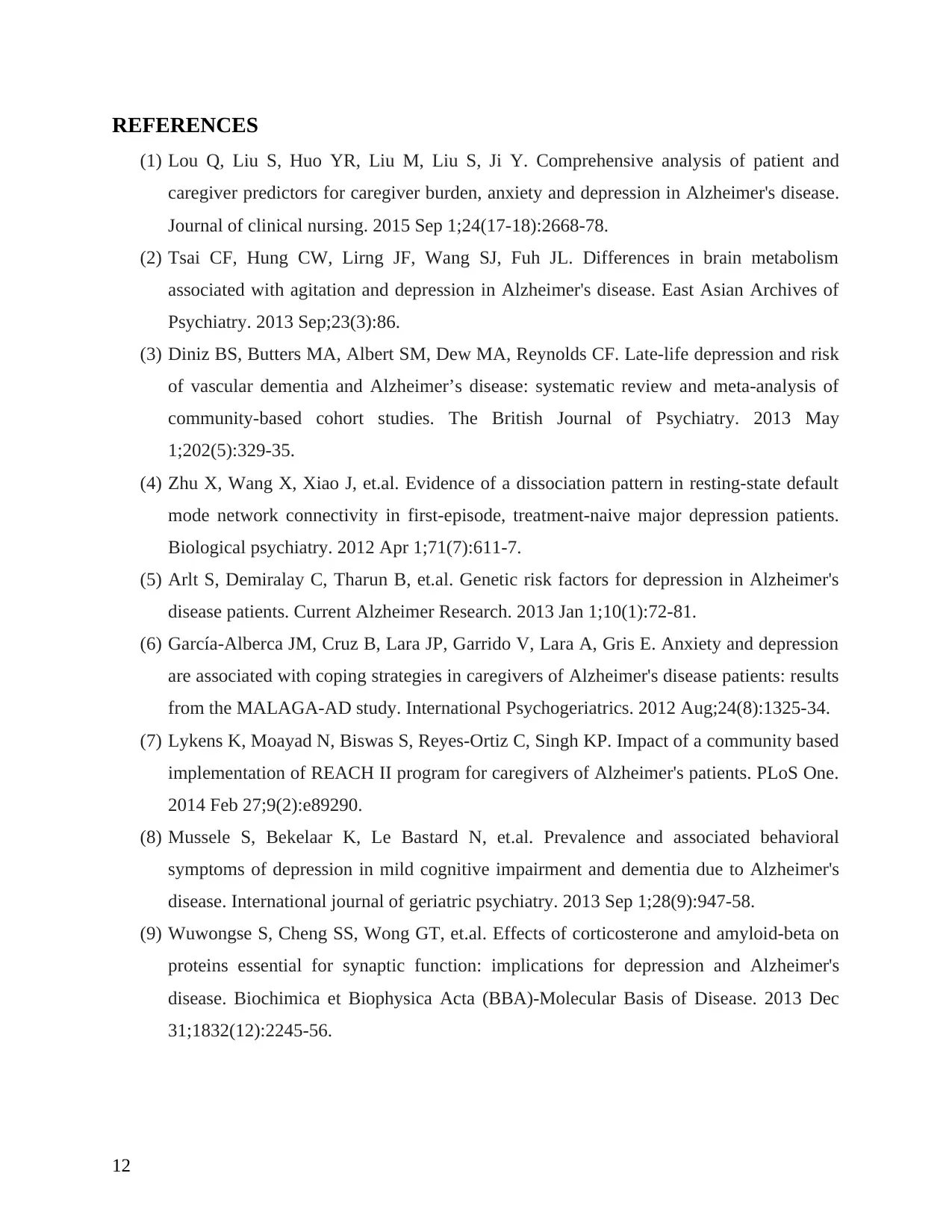
REFERENCES
(1) Lou Q, Liu S, Huo YR, Liu M, Liu S, Ji Y. Comprehensive analysis of patient and
caregiver predictors for caregiver burden, anxiety and depression in Alzheimer's disease.
Journal of clinical nursing. 2015 Sep 1;24(17-18):2668-78.
(2) Tsai CF, Hung CW, Lirng JF, Wang SJ, Fuh JL. Differences in brain metabolism
associated with agitation and depression in Alzheimer's disease. East Asian Archives of
Psychiatry. 2013 Sep;23(3):86.
(3) Diniz BS, Butters MA, Albert SM, Dew MA, Reynolds CF. Late-life depression and risk
of vascular dementia and Alzheimer’s disease: systematic review and meta-analysis of
community-based cohort studies. The British Journal of Psychiatry. 2013 May
1;202(5):329-35.
(4) Zhu X, Wang X, Xiao J, et.al. Evidence of a dissociation pattern in resting-state default
mode network connectivity in first-episode, treatment-naive major depression patients.
Biological psychiatry. 2012 Apr 1;71(7):611-7.
(5) Arlt S, Demiralay C, Tharun B, et.al. Genetic risk factors for depression in Alzheimer's
disease patients. Current Alzheimer Research. 2013 Jan 1;10(1):72-81.
(6) García-Alberca JM, Cruz B, Lara JP, Garrido V, Lara A, Gris E. Anxiety and depression
are associated with coping strategies in caregivers of Alzheimer's disease patients: results
from the MALAGA-AD study. International Psychogeriatrics. 2012 Aug;24(8):1325-34.
(7) Lykens K, Moayad N, Biswas S, Reyes-Ortiz C, Singh KP. Impact of a community based
implementation of REACH II program for caregivers of Alzheimer's patients. PLoS One.
2014 Feb 27;9(2):e89290.
(8) Mussele S, Bekelaar K, Le Bastard N, et.al. Prevalence and associated behavioral
symptoms of depression in mild cognitive impairment and dementia due to Alzheimer's
disease. International journal of geriatric psychiatry. 2013 Sep 1;28(9):947-58.
(9) Wuwongse S, Cheng SS, Wong GT, et.al. Effects of corticosterone and amyloid-beta on
proteins essential for synaptic function: implications for depression and Alzheimer's
disease. Biochimica et Biophysica Acta (BBA)-Molecular Basis of Disease. 2013 Dec
31;1832(12):2245-56.
12
(1) Lou Q, Liu S, Huo YR, Liu M, Liu S, Ji Y. Comprehensive analysis of patient and
caregiver predictors for caregiver burden, anxiety and depression in Alzheimer's disease.
Journal of clinical nursing. 2015 Sep 1;24(17-18):2668-78.
(2) Tsai CF, Hung CW, Lirng JF, Wang SJ, Fuh JL. Differences in brain metabolism
associated with agitation and depression in Alzheimer's disease. East Asian Archives of
Psychiatry. 2013 Sep;23(3):86.
(3) Diniz BS, Butters MA, Albert SM, Dew MA, Reynolds CF. Late-life depression and risk
of vascular dementia and Alzheimer’s disease: systematic review and meta-analysis of
community-based cohort studies. The British Journal of Psychiatry. 2013 May
1;202(5):329-35.
(4) Zhu X, Wang X, Xiao J, et.al. Evidence of a dissociation pattern in resting-state default
mode network connectivity in first-episode, treatment-naive major depression patients.
Biological psychiatry. 2012 Apr 1;71(7):611-7.
(5) Arlt S, Demiralay C, Tharun B, et.al. Genetic risk factors for depression in Alzheimer's
disease patients. Current Alzheimer Research. 2013 Jan 1;10(1):72-81.
(6) García-Alberca JM, Cruz B, Lara JP, Garrido V, Lara A, Gris E. Anxiety and depression
are associated with coping strategies in caregivers of Alzheimer's disease patients: results
from the MALAGA-AD study. International Psychogeriatrics. 2012 Aug;24(8):1325-34.
(7) Lykens K, Moayad N, Biswas S, Reyes-Ortiz C, Singh KP. Impact of a community based
implementation of REACH II program for caregivers of Alzheimer's patients. PLoS One.
2014 Feb 27;9(2):e89290.
(8) Mussele S, Bekelaar K, Le Bastard N, et.al. Prevalence and associated behavioral
symptoms of depression in mild cognitive impairment and dementia due to Alzheimer's
disease. International journal of geriatric psychiatry. 2013 Sep 1;28(9):947-58.
(9) Wuwongse S, Cheng SS, Wong GT, et.al. Effects of corticosterone and amyloid-beta on
proteins essential for synaptic function: implications for depression and Alzheimer's
disease. Biochimica et Biophysica Acta (BBA)-Molecular Basis of Disease. 2013 Dec
31;1832(12):2245-56.
12
⊘ This is a preview!⊘
Do you want full access?
Subscribe today to unlock all pages.

Trusted by 1+ million students worldwide
1 out of 13